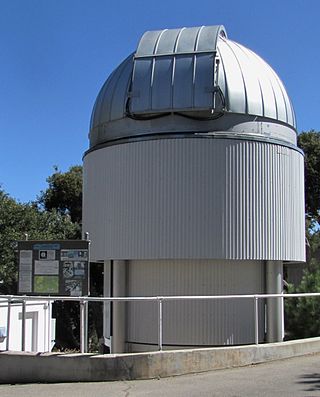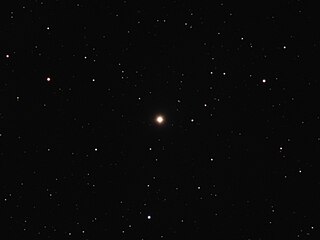Related Research Articles

Altair is the brightest star in the constellation of Aquila and the twelfth-brightest star in the night sky. It has the Bayer designation Alpha Aquilae, which is Latinised from α Aquilae and abbreviated Alpha Aql or α Aql. Altair is an A-type main-sequence star with an apparent visual magnitude of 0.77 and is one of the vertices of the Summer Triangle asterism; the other two vertices are marked by Deneb and Vega. It is located at a distance of 16.7 light-years from the Sun. Altair is currently in the G-cloud—a nearby interstellar cloud, an accumulation of gas and dust.

Radio astronomy is a subfield of astronomy that studies celestial objects at radio frequencies. The first detection of radio waves from an astronomical object was in 1933, when Karl Jansky at Bell Telephone Laboratories reported radiation coming from the Milky Way. Subsequent observations have identified a number of different sources of radio emission. These include stars and galaxies, as well as entirely new classes of objects, such as radio galaxies, quasars, pulsars, and masers. The discovery of the cosmic microwave background radiation, regarded as evidence for the Big Bang theory, was made through radio astronomy.

The table lists various objects and units by the order of magnitude of their volume.

The Mount Wilson Observatory (MWO) is an astronomical observatory in Los Angeles County, California, United States. The MWO is located on Mount Wilson, a 5,710-foot (1,740-meter) peak in the San Gabriel Mountains near Pasadena, northeast of Los Angeles.

An occultation is an event that occurs when one object is hidden from the observer by another object that passes between them. The term is often used in astronomy, but can also refer to any situation in which an object in the foreground blocks from view (occults) an object in the background. In this general sense, occultation applies to the visual scene observed from low-flying aircraft when foreground objects obscure distant objects dynamically, as the scene changes over time.

In astronomy, an extraterrestrial sky is a view of outer space from the surface of an astronomical body other than Earth.

The Navy Precision Optical Interferometer (NPOI) is an American astronomical interferometer, with the world's largest baselines, operated by the Naval Observatory Flagstaff Station (NOFS) in collaboration with the Naval Research Laboratory (NRL) and Lowell Observatory. The NPOI primarily produces space imagery and astrometry, the latter a major component required for the safe position and navigation of all manner of vehicles for the DoD. The facility is located at Lowell's Anderson Mesa Station on Anderson Mesa about 25 kilometers (16 mi) southeast of Flagstaff, Arizona (US). Until November 2011, the facility was known as the Navy Prototype Optical Interferometer (NPOI). Subsequently, the instrument was temporarily renamed the Navy Optical Interferometer, and now permanently, the Kenneth J. Johnston Navy Precision Optical Interferometer (NPOI) – reflecting both the operational maturity of the facility, and paying tribute to its principal driver and retired founder, Kenneth J. Johnston.

Chi Ursae Majoris or χ Ursae Majoris, formally named Taiyangshou, is a single star in the northern circumpolar constellation of Ursa Major. The star has an orange hue and is visible to the naked eye at night with an apparent visual magnitude of 3.72. It is located at a distance of approximately 184 light-years from the Sun based on parallax, but is drifting closer with a radial velocity of −9 km/s.

The CHARA array is an optical interferometer, located on Mount Wilson, California. The array consists of six 1-metre (40 in) telescopes operating as an astronomical interferometer. Construction was completed in 2003. CHARA is owned by Georgia State University (GSU).

Mu Pegasi or μ Pegasi, formally named Sadalbari, is a star in the northern constellation of Pegasus. The apparent visual magnitude of this star is 3.5, which is bright enough to be seen with the naked eye even on a moonlit night. Based upon parallax measurements taken during the Hipparcos mission, it is approximately 106 light-years from the Sun.

39 Arietis, officially named Lilii Borea, is a star in the northern constellation of Aries. It is visible to the naked eye with an apparent visual magnitude of +4.5. The distance to this star, as determined from an annual parallax shift of 19.01 mas, is approximately 172 light-years . This star was formerly located in the obsolete constellation Musca Borealis.

An astronomical interferometer or telescope array is a set of separate telescopes, mirror segments, or radio telescope antennas that work together as a single telescope to provide higher resolution images of astronomical objects such as stars, nebulas and galaxies by means of interferometry. The advantage of this technique is that it can theoretically produce images with the angular resolution of a huge telescope with an aperture equal to the separation, called baseline, between the component telescopes. The main drawback is that it does not collect as much light as the complete instrument's mirror. Thus it is mainly useful for fine resolution of more luminous astronomical objects, such as close binary stars. Another drawback is that the maximum angular size of a detectable emission source is limited by the minimum gap between detectors in the collector array.

A solar eclipse occurs when the Moon passes between Earth and the Sun, thereby obscuring the view of the Sun from a small part of the Earth, totally or partially. Such an alignment occurs approximately every six months, during the eclipse season in its new moon phase, when the Moon's orbital plane is closest to the plane of the Earth's orbit. In a total eclipse, the disk of the Sun is fully obscured by the Moon. In partial and annular eclipses, only part of the Sun is obscured. Unlike a lunar eclipse, which may be viewed from anywhere on the night side of Earth, a solar eclipse can only be viewed from a relatively small area of the world. As such, although total solar eclipses occur somewhere on Earth every 18 months on average, they recur at any given place only once every 360 to 410 years.
The United States Naval Observatory Flagstaff Station (NOFS), is an astronomical observatory near Flagstaff, Arizona, US. It is the national dark-sky observing facility under the United States Naval Observatory (USNO). NOFS and USNO combine as the Celestial Reference Frame manager for the U.S. Secretary of Defense.
Australian Aboriginal astronomy is a name given to Aboriginal Australian culture relating to astronomical subjects – such as the Sun and Moon, the stars, planets, and the Milky Way, and their motions on the sky.
The Oliver Observing Station is an independent professional astronomical observatory named after Barnard M. Oliver. It is owned and operated by The Monterey Institute for Research in Astronomy (MIRA).

Eta Herculis is a fourth-magnitude star in the constellation Hercules.
This glossary of astronomy is a list of definitions of terms and concepts relevant to astronomy and cosmology, their sub-disciplines, and related fields. Astronomy is concerned with the study of celestial objects and phenomena that originate outside the atmosphere of Earth. The field of astronomy features an extensive vocabulary and a significant amount of jargon.

Astronomy Photographer of the Year is an annual astronomy photography competition and exhibition that is organised by the Royal Observatory, Greenwich.
References
- ↑ "Tyler Nordgren". University of Redlands. Retrieved 15 March 2017.
- ↑ "Tyler Nordgren". University of Redlands. Retrieved 15 March 2017.
- ↑ "Tyler Nordgren". University of Redlands. Retrieved 15 March 2017.
- ↑ "Tyler Nordgren Biography". Space Art Travel. Retrieved 15 March 2017.
- ↑ "North American Sundial Society". North American Sundial Society. Retrieved 20 March 2017.
- ↑ "Physics, up close and personal". Redlands Daily Facts. 7 May 2013. Retrieved 20 March 2017.
- ↑ "I Was Robbed of My Eclipse Experience. Don't Let That Happen To You". NBC News. Retrieved 3 April 2017.
- ↑ "NASA Reported: On August 21 US Citizens Will Experience Total Solar Eclipse For The First Time In 99 Years". The Science Times. 22 March 2017. Retrieved 3 April 2017.
- ↑ "Tyler Nordgren Books". Space Art Travel. Retrieved 20 March 2017.
- ↑ "Tyler Nordgren". University of Redlands. Retrieved 20 March 2017.
- ↑ "Tyler Nordgren Biography". Space Art Travel. Retrieved 20 March 2017.
- ↑ "Tyler Nordgren Biography". Space Art Travel. Retrieved 20 March 2017.
- ↑ "Acadia Night Sky Festival". Acadia Night Sky Festival. Retrieved 20 March 2017.
- ↑ "Acadia Night Sky Festival". Space Art Travel. Retrieved 20 March 2017.
- ↑ "Milky Way Posters". Space Art Travel. Retrieved 20 March 2017.
- ↑ "Tyler Nordgren Books". Space Art Travel. Retrieved 20 March 2017.
- ↑ "Tyler Nordgren Biography". Space Art Travel. Retrieved 20 March 2017.
- ↑ "Tyler Nordgren". University of Redlands. Retrieved 20 March 2017.
- ↑ "Book review: Sun Moon Earth by Tyler Nordgren". Astronomy Magazine. Retrieved 4 April 2017.
- ↑ Sun Moon Earth: The History of Solar Eclipses from Omens of Doom to Einstein and Exoplanets. Basic Books. 13 September 2016. Retrieved 4 April 2017– via Amazon.
- ↑ Nordgren, Tyler (21 May 2010). Stars Above, Earth Below A Guide to Astronomy in the National Parks. Springer. ISBN 9781441916488 . Retrieved 4 April 2017.
- ↑ Nordgren, Tyler E.; Lane, B. F.; Hindsley, R. B.; Kervella, P. (2002). "Calibration of the Barnes-Evans Relation Using Interferometric Observations of Cepheids". The Astronomical Journal. 123 (6): 3380–3386. arXiv: astro-ph/0203130 . Bibcode:2002AJ....123.3380N. doi:10.1086/340567. S2CID 17862496.
- ↑ Nordgren, Tyler E.; Sudol, J. J.; Mozurkewich, D. (2001). "Comparison of Stellar Angular Diameters from the NPOI, the Mark III Optical Interferometer, and the Infrared Flux Method". The Astronomical Journal. 122 (5): 2707–2712. Bibcode:2001AJ....122.2707N. doi: 10.1086/323546 .
- ↑ Nordgren, Tyler E.; Germain, M. E.; Benson, J. A.; Mozurkewich, D.; Sudol, J. J.; Elias Ii, N. M.; Hajian, Arsen R.; White, N. M.; Hutter, D. J.; Johnston, K. J.; Gauss, F. S.; Armstrong, J. T.; Pauls, T. A.; Rickard, L. J. (1999). "Stellar Angular Diameters of Late-Type Giants and Supergiants Measured with the Navy Prototype Optical Interferometer". The Astronomical Journal. 118 (6): 3032–3038. Bibcode:1999AJ....118.3032N. doi: 10.1086/301114 .